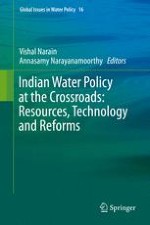2016 | OriginalPaper | Chapter
6. Independent Regulatory Agencies in Water Sector in India: Debate and Discourse
Author : Sachin Warghade
Published in: Indian Water Policy at the Crossroads: Resources, Technology and Reforms
Publisher: Springer International Publishing
Activate our intelligent search to find suitable subject content or patents.
Select sections of text to find matching patents with Artificial Intelligence. powered by
Select sections of text to find additional relevant content using AI-assisted search. powered by
